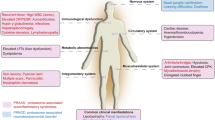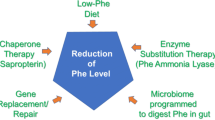Abstract
Alkaptonuria (AKU) is an autosomal recessive disorder caused by a deficiency of homogentisate 1,2 dioxygenase (HGD) and characterized by homogentisic aciduria, ochronosis, and ochronotic arthritis. The defect is caused by mutations in the HGD gene, which maps to the human chromosome 3q21–q23. AKU shows a very low prevalence (1:100,000–250,000) in most ethnic groups, but there are countries such as Slovakia and the Dominican Republic in which the incidence of this disorder rises to as much as 1:19,000. In this work, we summarize the genetic aspects of AKU in general and the distribution of all known disease-causing mutations reported so far. We focus on special features of AKU in Slovakia, which is one of the countries with an increased incidence of this rare metabolic disorder.



Similar content being viewed by others
References
Al-Sbou M, Mwafi N (2010) Nine cases of alkaptonuria in one family in southern Jordan. Rheumatol Int (in press)
Anikster Y, Nyhan WL, Gahl WA (1998) Ntbc and alkaptonuria. Am J Hum Genet 63:920–921
Aquaron R, Rodríguez de Córdoba S, Peñalva MA, Badens C, Roux H (2009) Alkaptonuria, ochronosis and ochronotic arthropathy in mainland France and the Reunion Island. A report of clinical and molecular findings. Current Rheumatol Rev 5:111–125
Beltrán-Valero de Bernabé D, Granadino B, Chiarelli I et al (1998) Mutation and polymorphism analysis of the human homogentisate 1, 2-dioxygenase gene in alkaptonuria patients. Am J Hum Genet 62:776–784
Beltrán-Valero de Bernabé D, Jimenez FJ, Aquaron R, Rodríguez de Córdoba S (1999a) Analysis of alkaptonuria (AKU) mutations and polymorphisms reveals that the CCC sequence motif is a mutational hot spot in the homogentisate 1,2 dioxygenase gene (HGO). Am J Hum Genet 64:1316–1322
Beltrán-Valero de Bernabé D, Peterson P, Luopajarvi K et al (1999b) Mutational analysis of the HGO gene in Finnish alkaptonuria patients. J Med Genet 36:922–923
Bromberg Y, Rost B (2007) SNAP: predict effect of non-synonymous polymorphisms on function. Nucleic Acids Res 35:3823–3835
den Dunnen JT, Antonarakis SE (2000) Mutation nomenclature extensions and suggestions to describe complex mutations: a discussion. Hum Mutat 15:7–12
Desmet FO, Hamroun D, Lalande M, Collod-Beroud G, Claustres M, Beroud C (2009) Human splicing finder: an online bioinformatics tool to predict splicing signals. Nucleic Acids Res 37:e67
Felbor U, Mutsch Y, Grehn F, Muller CR, Kress W (1999) Ocular ochronosis in alkaptonuria patients carrying mutations in the homogentisate 1,2-dioxygenase gene. Br J Ophthalmol 83:680–683
Fernández-Cañón JM, Peñalva MA (1995) Molecular characterization of a gene encoding a homogentisate dioxygenase from Aspergillus nidulans and identification of its human and plant homologues. J Biol Chem 270:21199–21205
Fernández-Cañón JM, Granadino B, Beltrán-Valero de Bernabé D et al (1996) The molecular basis of alkaptonuria. Nat Genet 14:19–24
Garrod AE (1902) (1902) The incidence of alkaptonuria: a study in chemical individuality. Lancet 2:1616–1620
Garrod AE (1908) Croonian lectures on inborn errors of metabolism, lecture II: alkaptonuria. Lancet 2:73–79
Gehrig A, Schmidt SR, Muller CR, Srsen S, Srsnova K, Kress W (1997) Molecular defects in alkaptonuria. Cytogenet Cell Genet 76:14–16
Goicoechea De Jorge E, Lorda I, Gallardo ME et al (2002) Alkaptonuria in the Dominican Republic: identification of the founder AKU mutation and further evidence of mutation hot spots in the HGO gene. J Med Genet 39:E40
Granadino B, Beltrán-Valero de Bernabé D, Fernández-Cañón JM, Peñalva MA, Rodríguez de Córdoba S (1997) The human homogentisate 1,2-dioxygenase (HGO) gene. Genomics 43:115–122
Grasko JM, Hooper AJ, Brown JW, McKnight CJ, Burnett JR (2009) A novel missense HGD gene mutation, K57N, in a patient with alkaptonuria. Clin Chim Acta 403:254–256
Higashino K, Liu W, Ohkawa T et al (1998) A novel point mutation associated with alkaptonuria. Clin Genet 53:228–229
Janocha S, Wolz W, Srsen S et al (1994) The human gene for alkaptonuria (AKU) maps to chromosome 3q. Genomics 19:5–8
Khachadurian A, Feisal KA (1958) Alkaptonuria; report of a family with seven cases appearing in four successive generations, with metabolic studies in one patient. J Chronic Dis 7:455–465
La Du BN (1958) Alkaptonuria. In: Scriver CR, Beauder AL, Sly W, Valle D (eds) The metabolic and molecular bases of inherited disease. McGraw Hill, New York, pp 1371–1386
La Du BN, Zannoni VG, Laster L, Seegmiller JE (1958) The nature of the defect in tyrosine metabolism in alcaptonuria. J Biol Chem 230:251–260
Ladjouze-Rezig A, Rodríguez de Córdoba S, Aquaron R (2006) Ochronotic rheumatism in Algeria: clinical, radiological, biological and molecular studies—a case study of 14 patients in 11 families. Joint Bone Spine 73:284–292
Mannoni A, Selvi E, Lorenzini S et al (2004) Alkaptonuria, ochronosis, and ochronotic arthropathy. Semin Arthritis Rheum 33:239–248
Milch RA (1955) Direct inheritance of alcaptonuria. Metabolism 4:513–518
Milch RA (1960) Studies of alcaptonuria: inheritance of 47 cases in eight highly inter-related Dominican kindreds. Am J Hum Genet 12:76–85
Montagutelli X, Lalouette A, Coude M, Kamoun P, Forest M, Guenet JL (1994) AKU, a mutation of the mouse homologous to human alkaptonuria, maps to chromosome 16. Genomics 19:9–11
Muller CR, Fregin A, Srsen S et al (1999) Allelic heterogeneity of alkaptonuria in Central Europe. Eur J Hum Genet 7:645–651
Ng PC, Henikoff S (2006) Predicting the effects of amino acid substitutions on protein function. Annu Rev Genomics Hum Genet 7:61–80
Oexle K, Engel K, Tinschert S, Haas D, Lee-Kirsch MA (2008) Three-generational alkaptonuria in a non-consanguineous family. J Inherit Metab Dis. doi:10.1007/s10545-008-0994-7
Phornphutkul C, Introne WJ, Perry MB et al (2002) Natural history of alkaptonuria. N Engl J Med 347:2111–2121
Pollak MR, Chou YH, Cerda JJ et al (1993) Homozygosity mapping of the gene for alkaptonuria to chromosome 3q2. Nat Genet 5:201–204
Porfirio B, Chiarelli I, Graziano C et al (2000) Alkaptonuria in Italy: polymorphic haplotype background, mutational profile, and description of four novel mutations in the homogentisate 1,2-dioxygenase gene. J Med Genet 37:309–312
Ramos SM, Hernández M, Roces A et al (1998) Molecular diagnosis of alkaptonuria mutation by analysis of homogentisate 1,2 dioxygenase mRNA from urine and blood. Am J Med Genet 78:192–194
Ranganath L, Taylor AM, Shenkin A et al (2011) Identification of alkaptonuria in the general population: a United Kingdom experience describing the challenges, possible solutions and persistent barriers. J Inherit Metab Dis 34:723–730
Rodríguez JM, Timm DE, Titus GP et al (2000) Structural and functional analysis of mutations in alkaptonuria. Hum Mol Genet 9:2341–2350
Srsen S, Varga F (1978) Screening for alkaptonuria in the newborn in Slovakia. Lancet 2:576
Srsen S, Muller CR, Fregin A, Srsnova K (2002) Alkaptonuria in Slovakia: thirty-two years of research on phenotype and genotype. Mol Genet Metab 75:353–359
Suwannarat P, O'Brien K, Perry MB et al (2005) Use of nitisinone in patients with alkaptonuria. Metabolism 54:719–728
Suzuki Y, Oda K, Yoshikawa Y, Maeda Y, Suzuki T (1999) A novel therapeutic trial of homogentisic aciduria in a murine model of alkaptonuria. J Hum Genet 44:79–84
Tinti L, Spreafico A, Braconi D et al (2010) Evaluation of antioxiodant drugs for the treatment of ochronotic alkaptonuria in an in vitro human cell model. J Cell Physiol 225:84–91
Titus GP, Mueller HA, Burgner J, Rodríguez de Córdoba S, Peñalva MA, Timm DE (2000) Crystal structure of human homogentisate dioxygenase. Nat Struct Biol 7:542–546
Toth K, Kiss-Laaszlo Z, Lenart E et al (2010) Familiar ochronotic arthropathy-caused by a gene mutation traced three hundred years. Joint Bone Spine 77:355–357
Uyguner O, Goicoechea de Jorge E, Cefle A et al (2003) Molecular analyses of the HGO gene mutations in Turkish alkaptonuria patients suggest that the R58fs mutation originated from central Asia and was spread throughout Europe and Anatolia by human migrations. J Inherit Metab Dis 26:17–23
Vilboux T, Kayser M, Introne W et al (2009) Mutation spectrum of homogentisic acid oxidase (HGD) in alkaptonuria. Hum Mutat 30:1611–1619
Walter K, Gaa A, Schaefer HE (1999) Sequence analysis of the homogentisate 1,2 dioxygenase gene in a family affected by alkaptonuria. J Med Genet 36:645–646
Zatkova A, Beltrán-Valero de Bernabé D, Polakova H et al (2000a) High frequency of alkaptonuria in Slovakia: evidence for the appearance of multiple mutations in HGO involving different mutational hot spots. Am J Hum Genet 67:1333–1339
Zatkova A, Polakova H, Micutkova L et al (2000b) Novel mutations in the homogentisate-1,2-dioxygenase gene identified in Slovak patients with alkaptonuria. J Med Genet 37:539–542
Zatkova A, Chmelikova A, Polakova H, Ferakova E, Kadasi L (2003) Rapid detection methods for five HGO gene mutations causing alkaptonuria. Clin Genet 63:145–149
Zatkova A, Sedlackova T, Radvansky J et al (2011) Identification of eleven novel homogentisate 1,2 dioxygenase (HGD) variants in alkaptonuria (AKU) patients and establishment of a novel LOVD based HGD mutation database. J Inherit Metab Dis (in press)
Acknowledgments
This work was supported by IMPG SAS and FNS UK Bratislava, Slovakia.
Author information
Authors and Affiliations
Corresponding author
Additional information
Communicated by: James A. Gallagher
Competing interest: None declared.
Electronic supplementary material
Below is the link to the electronic supplementary material.
Supplementary Table 1
List of all HGD mutations reported thus far with allele frequencies (526 AKU chromosomes from 267 families). Country of origin and references are indicated for all patients. Country of the first patient reported is listed as first, the first mutation report is indicated in bold. The short name and the original name are indicated for mutations for which the numbering has changed due to the HGVS nomenclature recommendations. DNA numbering is based on cDNA (NM_000187.3), with +1 corresponding to the A of the ATG. Gray shading indicates the 23 most frequent mutations that have been found in 361/496 (72.8%) of the AKU chromosomes carrying identified mutations. Variants IVS9-56G>A* and IVS9-17G>A* were published as mutations, but Vilboux et al. (2009) reported that they are most likely benign variants. Mutations G115fs** (c.413_434+35del57) and V157fs** (c.470-1_494del25) are caused by genomic deletions that are predicted to cause exon 6 and 8 skipping, respectively, thus leading to frameshift and preliminary stop of translation. A question mark in the column “Nucleotide change” indicates that the exact change is unknown or a published change is inconsistent with the gene sequence.(PDF 713 kb)
Rights and permissions
About this article
Cite this article
Zatkova, A. An update on molecular genetics of Alkaptonuria (AKU). J Inherit Metab Dis 34, 1127–1136 (2011). https://doi.org/10.1007/s10545-011-9363-z
Received:
Revised:
Accepted:
Published:
Issue Date:
DOI: https://doi.org/10.1007/s10545-011-9363-z




